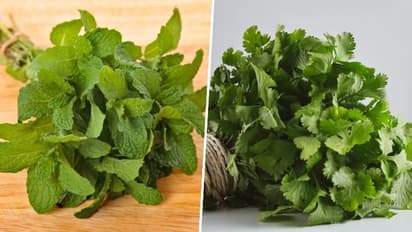Mint Vs Coriander: Which one is healthier and know their nutrition facts

Synopsis
Both mint (also known as peppermint) and coriander (also known as cilantro) offer unique flavours and potential health benefits. Their choice often comes down to personal preference and the intended use.
Mint and coriander offer distinct flavours that cater to different culinary preferences. Mint brings a refreshing and slightly sweet note, often used to enhance beverages, salads, and savoury dishes. Additionally, mint is known for its digestive benefits and soothing properties. On the other hand, coriander (cilantro) introduces a citrusy tang that complements a range of cuisines, commonly featured in salads, salsas, and curries. While both herbs have unique merits, their choice depends on the desired flavor profile and the prepared dish.
Here are some characteristics of both herbs to help you decide:
Mint:
- Flavour: Mint has a refreshing and cooling flavor with a slightly sweet undertone. It can add a pleasant zing to dishes.
- Common Uses: Mint is commonly used in both sweet and savory dishes. It's often added to beverages, salads, desserts, and savory dishes like lamb or salads.
- Health Benefits: Mint is known for its digestive benefits and soothing properties. It can help alleviate indigestion and bloating. It's also used for its potential to relieve headaches and improve respiratory health.
- Varieties: There are different types of mint, including spearmint and peppermint, each with slightly different flavors and uses.
Coriander (Cilantro):
- Flavour: Coriander has a citrusy, slightly tangy flavor with a hint of earthiness. Some people find it refreshing, while others might describe it as soapy or strong.
- Common Uses: Coriander leaves (cilantro) are commonly used in various cuisines, including Mexican, Indian, and Middle Eastern. They're added to salads, salsas, curries, and more.
- Health Benefits: Coriander is rich in antioxidants and has potential anti-inflammatory properties. It's also a good source of vitamins and minerals.
- Culinary Uses: Coriander seeds are used as a spice in cooking and have a slightly different flavour profile than the leaves. They are used in spice blends, curries, and pickles.
Also Read: Pathways to a lifetime of well-being: Unveiling the 5 keys to longevity and fulfillment
Ultimately, the choice between mint and coriander depends on the flavour profile you're seeking and the type of dish you're preparing. Mint is often chosen for its freshness and cooling effect, while coriander leaves add a distinct citrusy flavour to dishes. It's also worth noting that personal taste can greatly influence which herb you prefer.
Also Read: Here are 7 ways to keep your nails clean
Explore the latest Lifestyle News covering fashion, wellness, travel, Food and Recipes, and more. Stay updated with trending Health News, fitness tips, and expert insights to inspire your daily living. Discover personalized lifestyle trends that keep you stylish and informed. Download the Asianet News Official App from the Android Play Store and iPhone App Store for everything that adds value to your everyday life.